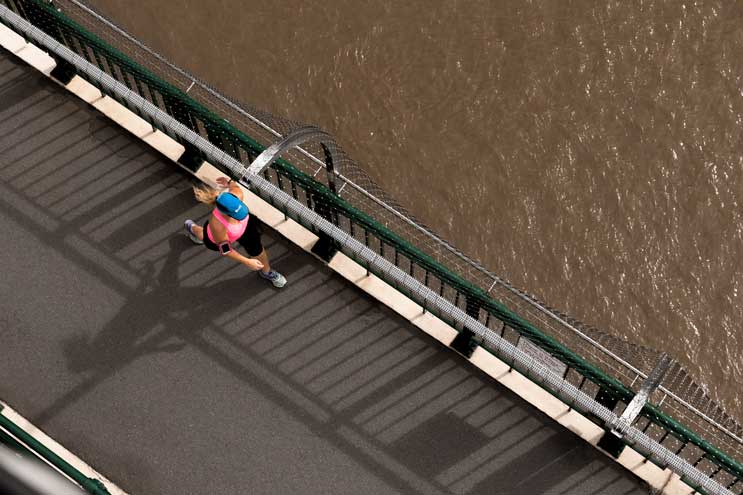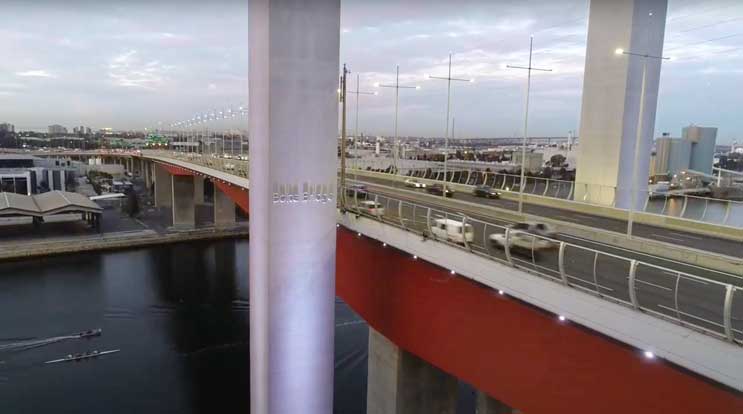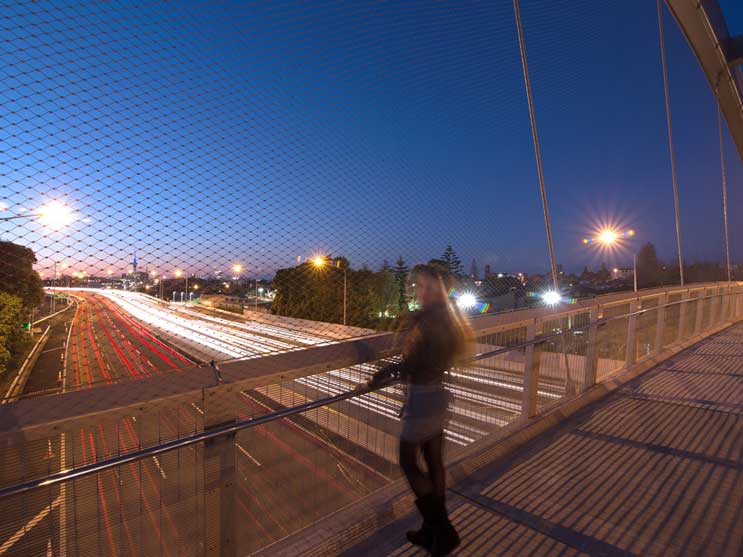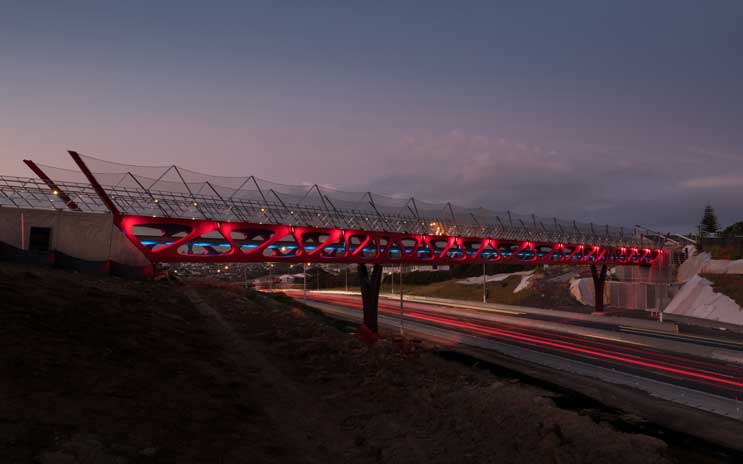
Introduction
Bridges are an essential part of civic infrastructure, particularly when they enable pedestrian and vehicle traffic to travel over roads, railways, bodies of water and other geographic features. Depending on their cultural significance, they can also be central to creating a strong sense of place and visual identity, a prime example being the Sydney Harbour Bridge.
However, bridges and overpasses present designers and specifiers with several unique challenges, including the need for safety and fall prevention. Measures are required to prevent people from climbing and falling or jumping off the structure. Without such measures, bridges can become suicide “hotspots”, resulting in loss of life that brings distress to the community and unwanted media attention that can lead to further suicide attempts at the same site. Local research has shown that erecting safety barriers at these hotspots has a significant impact on reducing the number of self-inflicted deaths by jumping in the area.1
In addition, barriers can inhibit the throwing of objects from the bridge onto the road, body of water, pedestrian walkway or rail track below. In 2018, the Adelaide government moved swiftly to install anti-throw screening on “all unprotected bridges” on the Southern Expressway following more than 40 incidents of rock throwing onto the highway.2
It is essential for design professionals to be familiar with the regulatory requirements for safety and fall prevention mechanisms on bridges, and the variety of design solutions that enable those requirements to be met.
In this whitepaper, we take a close look at the regulations currently governing the use of safety measures on Australian bridges and overpasses and explore ways of meeting them without compromising other design characteristics such as structural integrity, performance and aesthetics.
“With flexible stainless steel cable mesh, design professionals can create light, transparent barriers of high load capacity.”

In Australia, bridge design is regulated by AS 5100 – Bridge Design, commonly known as the “Bridge Code”. Most recently updated in 2017, the Bridge Code sets forth the minimum design standards with respect to bridges including design loads, foundations, bearings and deck joints, and waterproofing. In Part 1 of the Code (AS 5100.1:2017), Section 16 covers pedestrian and bicycle path barriers on bridges, including a requirement in Section 16.4 for protection to prevent people falling or objects being thrown from bridges. In this regard, allowable protection methods include: fully enclosed pedestrian bridges; solid opaque parapet walls of at least 2.4m tall; and protection screens.
These requirements should be read in conjunction with guidance from the “relevant authority”, typically the owner of the bridge or the road or railway corridor over which it passes. For example, in New South Wales, the Roads and Maritime Services document “Bridge Technical Direction BTD2012/01”3 provides further guidance for the installation of safety screens in addition to a risk assessment matrix that aids in determining the most appropriate protection method. BTD2012/01 also requires that:
Designers and specifiers should also note that Part 2 of the Bridge Code (AS 5100.2:2017) covers the minimum design loads, forces and load effects for road, rail, pedestrian and cyclist path bridges, and other associated structures including barriers. These design load requirements will impact the design of any safety and fall protection structures installed on a bridge or overpass.
“The transparency of stainless steel cable mesh enables clear views and a lightweight appearance, providing designers unprecedented freedom to create compliant barriers that meet all functional requirements without sacrificing style or individual flair.”

In line with the options provided in Section 16.4, there are several methods of complying with the requirements of the Bridge Code with respect to preventing objects from being thrown or people falling from bridges. These include:
While these methods meet the basic requirements in Section 16.4, designers and specifiers should take note of their various shortcomings. For example, the traditional materials used to clad fully-enclosed solutions or to form opaque screens, like solid or perforated panels, result in heavier, less transparent structures and offer designers reduced scope for creativity and individuality.
Solid parapet walls, which may also be included for sound reflection and barriers, are often comprised of concrete, steel, or timber and can be extremely heavy. Due to their heavy weight, these walls add significant structural loads, necessitating costly and complex reinforcement. They may also be too heavy for retrofit application on older structures with less load-bearing capability. Solid walls may also attract wind loads, creating uncomfortable “wind tunnels” on pedestrian walkways. The aerodynamic performance of bridges, particularly slender or lighter weight bridges, will also be impacted by the addition of solid barriers, screens and walls.
There are also aesthetic considerations when selecting one of the above methods. Enclosed bridges using traditional cladding materials and opaque screens compromise the aesthetic value of a structure and block or restrict views. Both these factors can lead to a diminished user experience as well as detract from an area’s sense of visual and cultural identity.
An alternative to conventional safety and fall protection methods is the use of flexible stainless steel tensile cable mesh, a structurally-efficient material that is comprised of a net of small-diameter high-tensile structural cables. If correctly utilised in an appropriate design, flexible stainless steel cable mesh can contribute to compliance with Section 16.4 with only a fraction of the weight of solid concrete, steel or timber walls.

Stainless steel mesh offers several advantages over conventional materials. The composition of tensile structural cables lessens the need for additional reinforcements and enables the design of contemporary structures with minimal bulk and refined architectural expression. With flexible tensile cable mesh, design professionals can create light, transparent barriers of high load capacity. The porous nature of stainless steel cable mesh also attracts very little wind load compared to a solid wall, reducing pressure on the bridge’s structural system. Leading suppliers also offer a range of diameters and mesh sizes, providing flexibility to meet project-specific requirements and achieve compliance with building and safety standards.
The use of stainless steel can also contribute to meeting sustainability targets for a project. According to the Australian Stainless Steel Development Association, stainless steel has several properties that elevate its sustainability value.4 Stainless steel is highly durable, requiring minimal maintenance without excessive requirements for additional protection using potentially hazardous materials, such as paints, protective coatings and solvents.5 It is also 100% recyclable and is a preferred raw material input in steel making; new stainless steel is made up of at least 50% recycled stainless steel product and more than half of the stainless steel produced today has been previously used in other products.6
The above performance and sustainability benefits are balanced with high aesthetic value. The transparency of stainless steel cable mesh enables clear views and a lightweight appearance, providing designers unprecedented freedom to create compliant barriers that meet all functional requirements without sacrificing style or individual flair.
Under AS 5100.1:2017, the Bridge Code provides for protection screens to be made of mesh of particular apertures if the screen is greater than three metres high above the walkway surface. It does not specifically exclude flexible stainless steel cable mesh, which is considered compliant when the correct apertures are used.
Regardless of the national standard, each State and Territory has additional guidelines tailored to their own independent historic requirements for protection screens. Flexible mesh is a different product to those on which State and Territory guidelines have historically been developed. It works as a tensile cable net not as a rigid panel, relying on its tensile strength rather than its rigidity.
As noted earlier, AS 5100.2:2017 sets out design loads that the barrier shall be designed to resist (namely, wind and robust design loads). There are additional load guidelines nominated by each State and Territory that should be observed by designers and specifiers. Screens made from flexible stainless steel cable mesh can be designed for structural compliance in relation to both AS 5100.2:2017 and local guidelines.
If you would like us to make a presentation at your office or if we can help you develop your concept further, please contact us to discuss your project.
[1] Law, Chi‐kin, Jerneja Sveticic and Diego De Leo. “Restricting access to a suicide hotspot does not shift the problem to another location. An experiment of two river bridges in Brisbane, Australia.” Australian and New Zealand Journal of Public Health Vol. 38, No. 2 (2014): 134-138.
[2] Briggs, Casey. “Screens to be installed to stop growing spate of rock throwing along Southern Expressway.” ABC News. https://www.abc.net.au/news/2018-06-25/temporary-screens-to-stop-rock-throwing-on-sa-expressway/9907102 (accessed 13 November 2019).
[3] New South Wales Government. “Bridge Technical Direction BTD2012/01.” Roads & Maritime Services.
https://www.rms.nsw.gov.au/business-industry/partners-suppliers/documents/technical-directions/btd2012_01.pdf (accessed 13 November 2019).
[4] Australian Stainless Steel Development Association. “Sustainability.” ASSDA. https://www.assda.asn.au/stainless-steel/sustainability (accessed 13 November 2019).
[5] Ibid.
[6] Ibid.